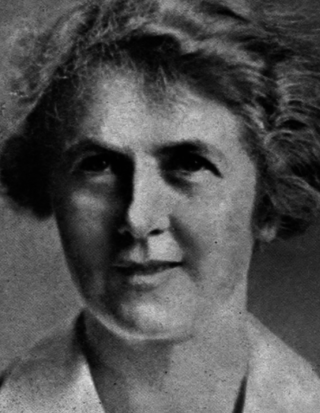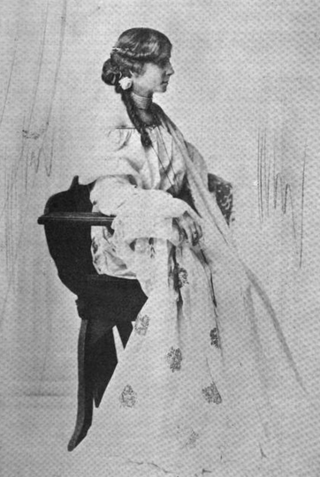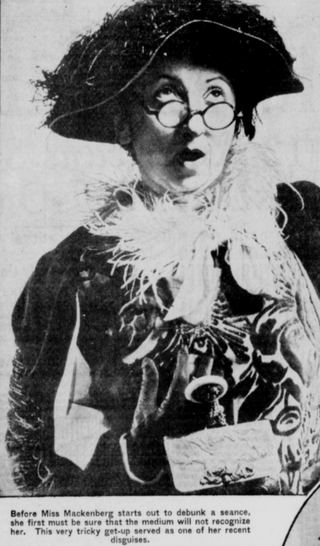
Remote viewing (RV) is the practice of seeking impressions about a distant or unseen subject, purportedly sensing with the mind. A remote viewer is expected to give information about an object, event, person, or location hidden from physical view and separated at some distance. Physicists Russell Targ and Harold Puthoff, parapsychology researchers at Stanford Research Institute (SRI), are generally credited with coining the term "remote viewing" to distinguish it from the closely related concept of clairvoyance. According to Targ, the term was first suggested by Ingo Swann in December 1971 during an experiment at the American Society for Psychical Research in New York City.
Cold reading is a set of techniques used by mentalists, psychics, fortune-tellers, and mediums. Without prior knowledge, a practiced cold-reader can quickly obtain a great deal of information by analyzing the person's body language, age, clothing or fashion, hairstyle, gender, sexual orientation, religion, ethnicity, level of education, manner of speech, place of origin, etc. during a line of questioning. Cold readings commonly employ high-probability guesses, quickly picking up on signals as to whether their guesses are in the right direction or not. The reader then emphasizes and reinforces any accurate connections while quickly moving on from missed guesses. Psychologists believe that this appears to work because of the Barnum effect and due to confirmation biases within people.

Sylvia Celeste Browne was an American writer and self-proclaimed medium and psychic. She appeared regularly on television and radio, including on The Montel Williams Show and Larry King Live, and hosted an hour-long online radio show on Hay House Radio.

Ray Hyman is a Professor Emeritus of Psychology at the University of Oregon in Eugene, Oregon, and a noted critic of parapsychology. Hyman, along with James Randi, Martin Gardner and Paul Kurtz, is one of the founders of the modern skeptical movement. He is the founder and leader of the Skeptic's Toolbox. Hyman serves on the Executive Council for the Committee for Skeptical Inquiry.

In Spiritualism, paranormal literature and some religions, materialization is the creation or appearance of matter from unknown sources. The existence of materialization has not been confirmed by laboratory experiments. Numerous cases of fraudulent materialization demonstrations by mediums have been exposed.

Harry Price was a British psychic researcher and author, who gained public prominence for his investigations into psychical phenomena and exposing fraudulent spiritualist mediums. He is best known for his well-publicised investigation of the purportedly haunted Borley Rectory in Essex, England.

Allison DuBois is an American author and purported medium. DuBois claims she used her psychic abilities to assist U.S. law enforcement officials in solving crimes, forming the basis of the TV series Medium.

Mediumship is the practice of purportedly mediating communication between familiar spirits or spirits of the dead and living human beings. Practitioners are known as "mediums" or "spirit mediums". There are different types of mediumship or spirit channelling, including séance tables, trance, and ouija. The practice is associated with spiritualism and spiritism. A similar New Age practice is known as channeling.

Eusapia Palladino was an Italian Spiritualist physical medium. She claimed extraordinary powers such as the ability to levitate tables, communicate with the dead through her spirit guide John King, and to produce other supernatural phenomena.

Mina 'Margery' Crandon was an American psychic medium who performed under the stage name 'Margery' and claimed to channel her dead brother, Walter Stinson. Investigators who studied Crandon concluded that she had no such paranormal ability, and others detected her in outright deception. She became known as her alleged paranormal skills were touted by Sherlock Holmes author Sir Arthur Conan Doyle and were disproved by magician Harry Houdini. Crandon was investigated by members of the American Society for Psychical Research and employees of the Scientific American.
Gary E. Schwartz is an American psychologist, author, parapsychologist and professor at the University of Arizona and the director of its Laboratory for Advances in Consciousness and Health. Schwartz researches the veracity of mediums and energy healing. His mediumship experiments have been described as flawed by critics who have argued that they failed to use adequate precautions against fraud and sensory leakage, relied on non-standardized, untested dependent variables and unaccounted for researcher degrees of freedom.

The Afterlife Experiments: Breakthrough Scientific Evidence of Life After Death is a book written by Gary Schwartz and bestselling author William L. Simon, with a foreword by Deepak Chopra. The book, published in 2003, reviews several experiments which aimed to investigate the possibility of life after death through the use of psychic mediums. Included in these experiments is one filmed and aired as part of an HBO special. Two studies stemming from the experiments were also published in the Journal of the Society for Psychical Research. The substance of the book and the studies it describes was generally claimed by the media as scientific evidence of life after death. However, there was significant criticism from the scientific community of the studies, their methodologies, and resulting data analyses.
Rosemary Altea is a British author who describes herself as a medium and healer. She has appeared on various programs, including Larry King Live, The Oprah Winfrey Show, and featured in the series premiere of Penn & Teller: Bullshit! alongside mentalist Mark Edward. She has written six books and claims to have a "healing foundation".

Franek Kluski, real name Teofil Modrzejewski (1873-1943), was a Polish physical medium criticized by trained magicians and skeptics as a fraud. Kluski was best known for his séances in which alleged "spirit" molds of hands materialized. It was later demonstrated by Massimo Polidoro and chemist Luigi Garlaschelli that these molds could have easily been made by fraudulent methods.
James Van Praagh is an American writer and television personality who describes himself as a clairvoyant and spiritual medium. He has written numerous books, including The New York Times bestseller Talking to Heaven. Van Praagh was a producer and screenwriter on the 2002 CBS primetime semi-autobiographical miniseries Living with the Dead starring Ted Danson. He also hosted a short-lived paranormal talk show called Beyond with James Van Praagh.

Mark Edward was an American mentalist and author. He wrote books on mentalism and séance theory and production, including Psychic Blues (2009), where he discussed working for the Psychic Friends Network. Wilson made appearances on television as both primary consultant and on-air performer in programming such as ABC's The Con, A & E's Biography: "Houdini, the Great Escape", NBC's The Other Side, and Psychic Secrets Revealed, the Sci-Fi Channel's Mysteries, Magic and Miracles, Disney's Forces Beyond, as well as two episodes of the Learning Channel's Exploring the Unknown. His featured segment as a spirit medium on the pilot episode of Showtime's Penn & Teller's Bullshit! series, titled "Speaking with the Dead", helped secure an Emmy Award nomination for that episode in 2002. He coined the term "grief vampire" as a description of alleged psychic mediums who prey on vulnerable people. Edward was a fellow with the Committee for Skeptical Inquiry.

Anna Eva Fay Pingree was a famous medium and stage mentalist of the twentieth century.

Rose Mackenberg was an American investigator specializing in fraudulent psychic mediums, known for her association with Harry Houdini. She was chief of a team of undercover investigators who investigated mediums for Houdini in the 1920s. After Houdini's death, she continued to investigate spiritualist fraud for over 20 years and was known as an expert on the subject. She testified in court cases and before Congress and was interviewed in national magazines and on television.

Matthew L. Fraser, also known as Matt Fraser, is an American psychic medium, published author, and television personality. He is best known for his central role in the reality TV show Meet the Frasers. He has written four books including the We Never Die: Secrets of the Afterlife.
Beatrice Anne Gehman was an American psychic medium and the pastor of The Center for Spiritual Enlightenment, a Spiritualist church that she founded. She was one of the two main subjects of the book The Priest and the Medium: The Amazing True Story of Psychic Medium B. Anne Gehman and Her Husband, Former Jesuit Priest Wayne Knoll, PhD, by spiritual teacher and author Suzanne Giesemann. She was also featured in the HBO documentary by Steven Cantor, "No One Dies in Lily Dale."















